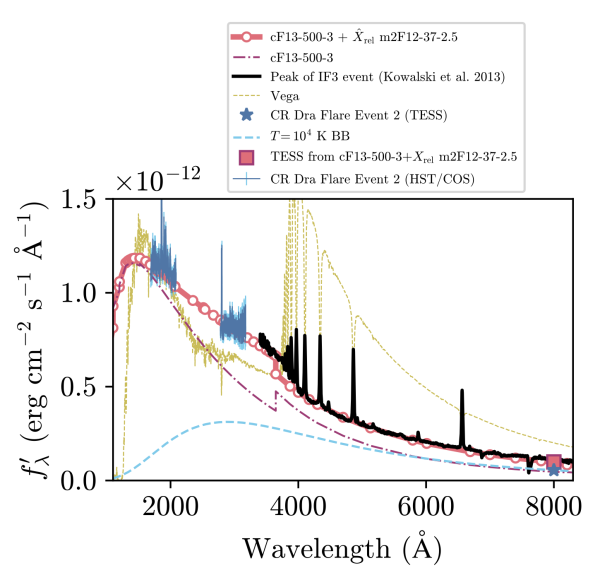Remarkable NUV Spectrum of an M-star Megaflare
| Nugget | |
|---|---|
| Number: | 479 |
| 1st Author: | Adam KOWALSKI |
| 2nd Author: | |
| Published: | |
| Next Nugget: | Unrequited currents |
| Previous Nugget: | Revised Point-Spread Functions of AIA and their effect on DEM analyses |
Introduction
Stellar flares probe explosive atmospheric conditions in plasma regimes that are not thought to be achieved on the Sun. Stellar flare data are available across a broad wavelength range with high temporal resolution, thus complementing the high spatial and spectral resolution of solar flare observations. Broad wavelength spectra facilitate comparisons to models of energy transport and deposition that are central to our understanding of solar flares. Near-ultraviolet (NUV) flare spectra in particular are crucial for evaluating the high-energy environment of potentially habitable planets around low-mass M-dwarf stars.
The NUV spectrum
Over recent decades, there has been a nearly complete empirical characterization of the optical spectral properties of [M-dwarf] [stellar flares] (e.g., Ref. [1]). However, the NUV extension of the continuum radiation has remained woefully unexplored, despite this being where most of the radiative energy is thought to be released. Not any more! A Hubble Space Telescope (HST) "Treasury Program" with the Cosmic Origins Spectrograph is conducting a comprehensive spectroscopic survey of M-dwarf flares. These data provide long-sought constraints on stellar flare continuum properties from the far-ultraviolet (~165 nm) to the edge of the U-band/optical at ~320 nm.
In the first paper from Treasury Program "Fulcrum", we report on the NUV spectra in two extremely energetic "megaflares" on the M-dwarf CR Dra (Ref. [2]). One of these flares is the most luminous NUV M-dwarf flare observed to date, and it radiated an energy well over 1035 erg. This is about 1000x larger than extreme solar flares. The impulsive-phase flare spectra of the two events are very surprising. Figure 1 places these spectra in context. The inferred continuum radiation in the long-wavelength NUV spectra is remarkably flat, but contrary to general expectations, a peak and turnover in the continuum radiation was not observed in the short-wavelength NUV spectra. Instead, the spectra are consistent with a more complicated spectral energy distribution that rises into the far-ultraviolet. Additionally, the emission lines of Mg II h and k, which are very bright in solar flare spectra from IRIS, rise very gradually and contribute little to the total radiated energy.

Model implications
Among all current radiative-hydrodynamic models of stellar flares, only those that have extremely large heating rates in the deep atmosphere can reproduce the continuum rise in the short-wavelength NUV spectra. The study models the deep heating with extreme flux densities of E > 500 keV electrons or E > 10 MeV protons, and these sources may represent scaled up analogies of bright kernels in two-ribbon solar flares.
Conclusion
In summary, a new HST Treasury program is providing a homogeneous data set of spectra spanning the entire NUV during flares of all sizes, ranging from large solar flare energies to megaflares. The spectra provide a fulcrum connecting the optical and far-ultraviolet regimes in stellar flares, facilitating much more accurate assessments of the high-energy radiation environment of exoplanets around M dwarfs. The study demonstrates the potential for broad wavelength coverage spectra to reveal pathways for new radiative and/or energy transport physics in stellar atmospheres. Important questions remain, such as where is the peak of flare continuum radiation in stellar flares if not in the NUV? To read more, see ...